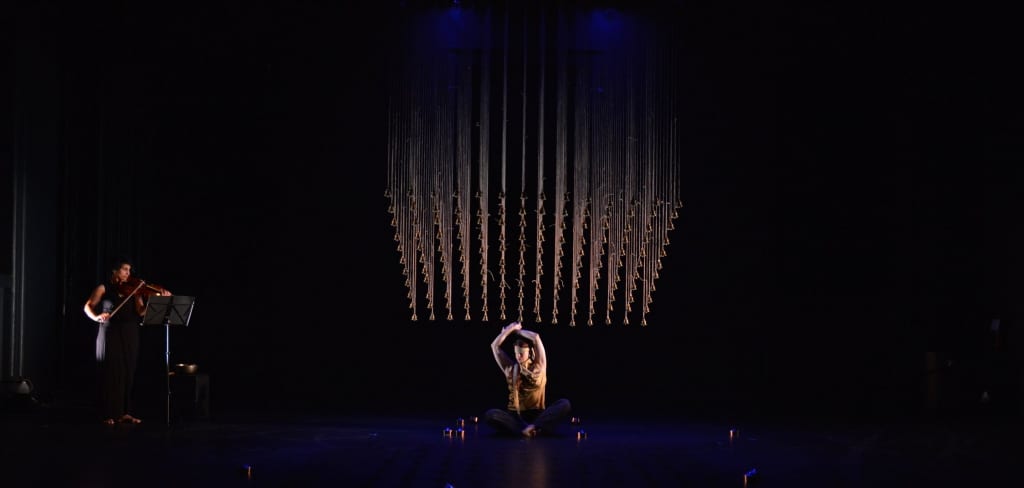What would truth and reconciliation look like, sound like, feel like, if it arrived through the body-knowledge of Indigenous, Black and Of Colour artists? Anandam Dancetheatre’s spellbinding contemporary dance series, Contemporaneity 2.0, invites its audience to explore this question in an evening of dance, art, and music that is precisely the kind of antidote to the mostly white, male, heteronormative, and still resolutely patriarchal responses to these issues and questions that artists and audiences of colour are forced to deal with on a regular basis in Toronto (see my review on the COC’s Canada 150 celebration production of Harry Somers’ Louis Riel if you want my take on missed opportunities).
Under the astute curatorial programming of Soraya Peerbaye, the three performances billed in today’s show traverse and test the boundaries of what we understand as contemporary dance. These performances provoke an engagement with contemporaneity that involves a nuanced exploration of the issues that define us now, and they are articulated by performers who can revise canonical expectations through their radically different myths of becoming.
In the first performance, “Ghandari,” Gitanjali Kolanad’s choreography powerfully revises the fundamentally patriarchal telling of a woman’s story as it originally appears in the Mahabharata. In the Hindu epic, Ghandari is a dutiful wife who chooses to blindfold herself on discovering that the husband to whom she has been given is blind. But what if Ghandari’s choice to blindfold herself is an act of agency, a reclamation of power through which she refuses to become the eyes and sight for her blind husband?
What unfolds in dance is a heart-stoppingly powerful and beautiful piece danced (mostly blindfolded) by Brandy Leary to a haunting alto line improvised on the viola by Parmela Attariwala. We see Ghandari grow in strength, even as she must contend with the eventual tragedy of the loss of all her 100 children. Leary traverses the stage blindfolded, arriving at copper bowls that she explores and upends, symbolically calling to mind the emptying of burial urns. This piece is a tour de force of artistic power, and the two performers, Leary and Attariwala, are so perfectly in sync that when Leary disturbs the carefully hung bells in the centre of the set, she does so in perfect rhythmic synchronization with the pulse of the viola—a veritable feat of improvisation and skill.

“Becoming,” the second performance, is a multimedia piece that blends image, sound, and movement into a narrative of reclamation that blends Indigenous and Black histories and mythologies. The piece creates a visionary bridge between the transatlantic slave trade and the erasure of Indigenous peoples even as it nostalgically evokes a primal relationship to the land through projected images of earth and water in pristine form. Trapped in a bubble (of history?) a young, Black woman struggles to emerge, only to discover, when she does, that history continues to speak through her inwardly scarred body. “Becoming” suggests that the traumatic violence of slavery has left its imprint on the body in ways that seem indelible; but perhaps, through the exploration of shared mythologies of healing, the Black/Indigenous/Of Colour body will find a way to incarnate a caring subjectivity that can come to terms with this trauma of history. While “Becoming” intends to explore these shared histories and mythologies of healing, unfortunately, the performance still had an unfinished and somewhat chaotic feel to it that ultimately compromised the overall effect of the piece.
For the third performance, choreographer Rhodnie Désir describes her work as emerging with almost mythical insistence—the work arrives, and demands that she bring it to being in movement. Set to hypnotic musical work arranged by Engone Endong, which recalls folk motifs from Gabon, a solitary white male subject explores the dance space as a metaphor for the self. The program notes to “MWON’D (uma)” describe the piece as an intimate exploration of the “troubled, spiritual space of being.” The title is a syncretic melding of the words “moun” (human), “mwen” (me), and “anmey” (cry of distress). Danced by Greg “Krypto” Sellinger, this powerful, troubled journey also makes us wonder what it means to be a man in this historical moment. Sellinger’s lithe and powerful physique and his force of dramatic presence made this piece simultaneously awe-inspiring and devastating—a cry of distress that one hopes is also a cry of self-discovery. While Endong’s music provided a powerful counterpoint to the dance, choppy editing and mixing of tracks sometimes marred the otherwise seamless performance taking place on stage.

The curatorial process of these works is described as an “act of centering, coming together and radical caring; of exchanging ways of knowing and unknowing.” This exchange brought forth a luminous and many-hued mythology of gestation and birth through the three works on stage. For our global readers of Playstosee.com, there are rumours that some of these pieces are poised to travel… in which case, treat yourself to the rare synergy of art, music, and dance born out of this place that we call Turtle Island when it arrives on your shores.

